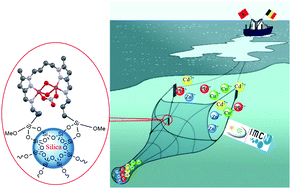A novel environment-friendly hybrid material based on a modified silica gel with a bispyrazole derivative for the removal of ZnII, PbII, CdII and CuII traces from aqueous solutions†‡
Abstract
The extraction and separation of heavy metals with several hybrid sorbents has been recognized as a promising green methodology. We present a novel and efficient host based on a modified silica gel with a bis(pyrazole)butane derivative as a chelating ligand; it was synthesized and studied for its adsorption capacity towards toxic heavy metals in aqueous media. The success of the synthesis of SiNAL4 was concluded from elemental analysis, Fourier transform-infrared spectroscopy, solid state 13C NMR, nitrogen adsorption–desorption isotherm, BET surface area, BJH pore size, scanning electron microscopy and thermogravimetry analysis. The effectiveness, regenerability and stability of the studied adsorbent were demonstrated. The optimum conditions for the removal of selected toxic metal ions were found to be pH = 6 and 25 min of contact time with the hybrid material. The maximum levels of ZnII, PbII, CdII and CuII uptake by the hybrid material were 86.51, 35.26, 26.96 and 20.24 mg g−1, respectively. The equilibrium isotherm models of the adsorbent were better described by a Langmuir model. The kinetics of heavy metal adsorption of the hybrid material followed a pseudo-second-order model and the thermodynamic parameters confirmed the spontaneous adsorption, and the spontaneity increases with the increase in temperature. The architecture of the hybrid material, when adsorbing the metal on the surface of the inorganic silica, was revealed using single crystal X-ray diffraction of a model material capturing CuII ions thanks to ligand coordination. Finally, the hybrid material was used in the treatment of river waters containing ZnII and CdII. The quantitative removal of the toxic metals under study from real aqueous solutions confirms the effectiveness of this new adsorbent compared to several previously described materials.



 Please wait while we load your content...
Please wait while we load your content...